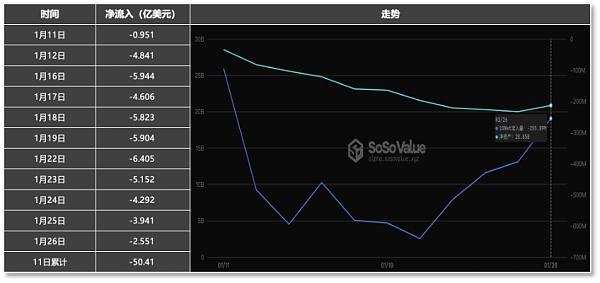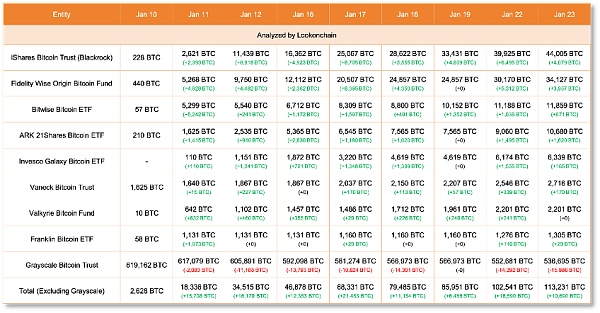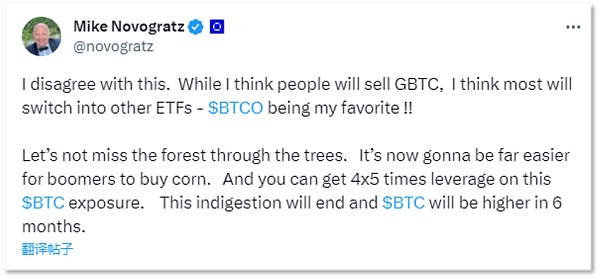Source: Weilin, Hive Tech
As of January 26, the 10 Bitcoin spot ETFs approved by the SEC have experienced 11 trading days. According to SoSo Value data, the total transaction value during this period reached US$1.67 billion, and the total net asset value was US$26.74 billion.
On the net inflow indicator, Grayscale’s GBTC continues to show negative values, that is, “net outflow.” On January 26 alone, the last trading day last week, GBTC’s single-day net outflow reached 255 million. US dollars, this is the smallest outflow except for the first day of trading.
As of January 26, GBTC has had a cumulative outflow of US$5.041 billion in 11 trading days. In addition to it, on January 26, the other 9 Bitcoin ETFs were all in a state of net inflows. The largest was Fidelity's FBTC, with a net inflow of approximately US$100 million; followed by BlackRock's IBIT, with a net inflow of $87.13 million.
In the past short historical trading days of the Bitcoin ETF products of these two companies, the single-day net inflow of funds has always been a "competition for first place" trend.
Analysts believe that the reason for the large outflow of funds from Grayscale GBTC is that after the product was converted from Bitcoin Trust to Bitcoin ETF, early investors redeemed arbitrage. In addition, GBTC is higher than similar products in the market. Management fees may also cause early investors to change hands, and their redemptions will lead to capital outflows. Correspondingly, Grayscale will also have to sell the Bitcoins it manages to handle redemption needs.
During this period, the continued outflow of funds from Grayscale GBTC brought selling pressure expectations to the BTC spot market, and the BTC price once fell below $40,000. However, as the net outflow of GBTC slowed down, the price of BTC rebounded. On January 28, BTC regained $42,000.
GBTC net outflow slows down, BTC regains US$42,000
Since the Bitcoin spot ETF was listed on the US market on January 11, 10 different The products launched by the company have attracted a total of US$26.74 billion in 11 trading days, but Grayscale’s GBTC has been lagging behind, and funds continue to flow out of it.
On the first day of listing and trading on January 11, GBTC had an outflow of US$95 million, which was also the day with the smallest capital outflow. Since then, the dollar value of outflows from the Bitcoin ETF has been in the hundreds of millions every day. On January 22 , GBTC's single-day capital outflow exceeded US$640 million, setting a record for the largest single-day capital outflow to date.
 GBTC’s net inflows since listing have continued to be negative
GBTC’s net inflows since listing have continued to be negative
After funds continue to leave GBTC, the crypto asset market is recording the number of Bitcoins sold by Grayscale. According to the current subscription/redemption rules of this ETF attribute product, when an investor requests to redeem/sell GBTC, Grayscale also needs to sell Bitcoin accordingly to handle the investor's redemption needs.
Lookonchain statistics as of January 23 show that on January 11, Grayscale sold more than 2,000 Bitcoins, and in the subsequent Bitcoin ETF trading days, Grayscale’s daily The selling volume was more than 10,000 coins, and even reached 14,000 coins twice.
 Lookonchain’s statistics on BTC holdings of various ETFs
Lookonchain’s statistics on BTC holdings of various ETFs
In addition, the sell-off of FTX , which is in the process of bankruptcy, also accounted for a large part of the capital outflow - 22 million shares of FTX were liquidated and sold GBTC is worth US$1 billion.
Bitcoin once soared to US$49,000 due to the approval of ETF, which is good for the implementation. In addition, funds are flowing out from GBTC, Grayscale is selling Bitcoin, and market selling pressure is expected to brew.
On January 23, Bitcoin fell below $40,000 after falling all the way, and the downward trend coincided with the capital outflow trend of Grayscale GBTC. Since GBTC set a record for net outflows on January 22, the net outflows have gradually shrunk. By January 26, the net inflows of the Bitcoin ETF have narrowed to US$255 million, and Bitcoin has rebounded again. , has now reached the $42,000 range.
In addition to Grayscale, the ability of other Bitcoin ETFs to attract money continues to grow, especially iShares Bitcoin Trust (IBIT) issued by BlackRock and Fidelity Wise Origin Bitcoin Fund (FBTC) issued by Fidelity. As of now, the total net inflows of these two ETFs are US$2.173 billion and US$1.925 billion respectively, and correspondingly the net asset values under management have reached US$2.19 billion and US$1.94 billion respectively.
Financial people predict: "Indigestion" will end in half a year
From the data, it can be seen that funds entering other Bitcoin ETFs do not seem to be able to offset the high amount of Grayscale GBTC Panic caused by capital outflows. When GBTC was converted into an ETF on January 11, the scale of the fund managed by Grayscale was as high as 25 billion US dollars, backed by 619,162 BTC.
Before this, GBTC was in the nature of a Bitcoin trust. It was established in 2013 and allowed investors to invest in Bitcoin without directly purchasing Bitcoin. They could invest in Bitcoin as long as they subscribed for GBTC shares.
However, GBTC as a trust product does not support redemption. That is, once investors subscribe for shares, they cannot redeem them for Bitcoin in the primary market. If they want to sell, they can only sell them through the secondary market of GBTC. out of stock. Therefore, GBTC will trade at a premium or discount (negative premium) relative to the underlying asset.
Since the beginning of 2021, the negative premium of GBTC has become higher and higher, reaching a discount peak of nearly 50% in December 2022. GBTC at half price has attracted many investors. Until the SEC accepted the transformation of GBTC into a Bitcoin ETF, the discount finally narrowed to close to 0, which means that many investors holding GBTC are likely to be in a state of substantial profits, and after GBTC was listed as a Bitcoin ETF, they chose Take profits.
JP Morgan analyst Nicholas Panigirzoglu analyzed that during 2023, investors were attracted by the discount to net asset value and invested up to 3 billion in the secondary market. USD GBTC, “If the previous estimate of $3 billion proves to be correct, and considering that $1.5 billion has already exited, then there may be another $1.5 billion that will exit the Bitcoin space through profit-taking on GBTC, thus in the future Several weeks have put further pressure on Bitcoin prices.”
In addition, Grayscale’s GBTC management fee rate is set at 1.5%. Its CEO believes that given GBTC’s liquidity, With a small spread and a good track record over the past ten years, "the 1.5% rate is reasonable." But this rate is ridiculously high compared to the 0.25% rate of 4 companies such as BlackRock and Fidelity. Franklin Templeton’s EZBC rate is as low as 0.19%.
Grayscale’s Bitcoin ETF is uncompetitive in the rate market, which may also cause some investors to switch to other Bitcoin ETF products with more suitable rates.
As for how long Grayscale’s sell-off will last, some analysts have expressed optimistic expectations.
On January 21st, Michael Novogratz, the founder of Galaxy Digital Holdings, an American crypto financial services company, posted on social media that although investors would sell GBTC, but most people will move to other ETFs. He is not worried about the current volatility and predicts that the market’s “indigestion” will end within six months and BTC will reach new highs.
 Novogratz predicts that the market's "indigestion" will end within six months
Novogratz predicts that the market's "indigestion" will end within six months
Another analyst analyzed the timing of the end of the selling pressure from Grayscale's selling data and said that the company is currently Holding more than 500,000 BTC, if calculated at a rate of 14,000 BTC per day, it will take about 39 days to completely sell off. “Taking into account the impact of non-working days, Grayscale may complete all sales in mid-March. ."
Indeed, except for Grayscale, the Bitcoin ETF products provided by other companies are all in a state of net inflow of funds. In the long run, the cycle of funds entering this new ETF will gradually lengthen, and multiple products It will also continue to attract funds into the market. Matthew Sigel, head of digital asset research at VanEck, believes that $40 billion will flow into the Bitcoin ETF market within two years, while Eric Balchunas, a senior Bloomberg ETF analyst, is more optimistic. It marks the amount of money it will attract within two years at US$50 billion.
 Coinlive
Coinlive 
 Coinlive
Coinlive  decrypt
decrypt Beincrypto
Beincrypto Cointelegraph
Cointelegraph Cointelegraph
Cointelegraph Cointelegraph
Cointelegraph Cointelegraph
Cointelegraph Cointelegraph
Cointelegraph Cointelegraph
Cointelegraph Cointelegraph
Cointelegraph